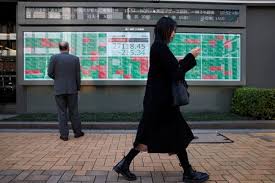Asian markets could be in for a choppy ride on Tuesday, with investors unsure whether to interpret Monday’s steep fall in U.S. Treasury yields and the dollar as an encouraging sign for risky assets or a warning that growth is evaporating. Given that Asian shares on Monday posted their biggest rise this year, before the weak ISM U.S. manufacturing report triggered the slide in yields, investors may err on the side of caution and pare back risk exposure, not add to it.
The Aftermath of Monday’s Market Movements
Understanding the U.S. Treasury Yield Drop
The sudden decline in U.S. Treasury yields on Monday sent ripples through global markets. This movement often signifies investors seeking safer assets, hinting at underlying concerns about economic growth. When yields drop, it’s generally a sign that bond prices are rising because demand is high.
The Dollar’s Steep Fall: What It Means
A significant drop in the dollar can impact global markets, especially those in Asia, which rely heavily on trade. A weaker dollar might suggest that the U.S. economy is slowing down, causing investors to reassess their positions in riskier assets.
Monday’s Market Rally in Asia
A Record Rise in Asian Shares
Asian markets saw their largest rise of the year on Monday, a surprising rebound that seemed to defy broader global concerns. This rally was driven by optimism that economic conditions were stabilizing, despite mixed signals from major economies.
The Role of the ISM U.S. Manufacturing Report
The weak ISM U.S. manufacturing report played a pivotal role in changing market sentiment. The report indicated that the manufacturing sector was struggling more than expected, leading to a reconsideration of growth prospects.
Investor Sentiment: Caution vs. Optimism
Navigating Market Volatility
Investors are now faced with a complex decision: should they interpret these signals as a buying opportunity or a warning sign? The mixed messages have created an environment of heightened uncertainty.
Balancing Risk and Reward
In times of market volatility, balancing risk and reward becomes crucial. While the potential for gains is tempting, the risks associated with economic slowdowns cannot be ignored.
Sector-Specific Impacts in Asia
Technology and Innovation
The technology sector in Asia, particularly in countries like South Korea and Japan, is often sensitive to changes in U.S. economic policies. A weaker dollar can mean higher costs for importing technology components, impacting profit margins.
Manufacturing and Exports
Manufacturing hubs across Asia might face challenges if the global demand weakens. The ISM report’s findings could hint at reduced demand for Asian exports, affecting countries like China and Vietnam.
Finance and Investment
Financial markets in Asia are highly interconnected with global trends. Banks and investment firms will need to navigate these choppy waters carefully, balancing short-term reactions with long-term strategies.
Strategies for Investors
Diversification: A Key Strategy
Investors are often advised to diversify their portfolios to mitigate risks. By spreading investments across various sectors and regions, the impact of market volatility can be reduced.
Keeping an Eye on Economic Indicators
Staying informed about key economic indicators, such as manufacturing reports and Treasury yields, is essential for making informed investment decisions. These indicators provide insights into broader economic trends.
Adopting a Long-Term Perspective
While short-term market movements can be unsettling, adopting a long-term investment perspective can help weather the storm. Historical trends show that markets tend to recover over time, even after significant downturns.
The day ahead in Asian markets promises to be volatile as investors react to the latest economic signals from the U.S. While Monday’s rise in Asian shares was a positive sign, the drop in U.S. Treasury yields and the dollar suggests that caution is warranted. By staying informed and adopting strategic investment practices, investors can navigate these uncertain times more effectively.




